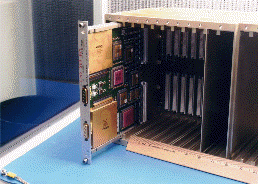
Avionics Hardware Engineering Model Completed
David H. Lehman
On February 24, 1995 the Mars Pathfinder Attitude and Information Management (AIM) completed the "build" phase of its engineering model hardware. This milestone represents a significant step on the road to launching the Pathfinder lander in early December of 1996. The AIM subsystem is the electronics and control center (or "brain" ) of the Mars Pathfinder flight system. Its performance is critical to the collection, storage, processing, and distribution of the mission's engineering and science data. This subsystem is also responsible for issuing commands for all other subsystems, performing attitude control, and for operating the lander's interfaces with the micro-rover and the mission operations system.
This engineering model allows Pathfinder's AIM engineers to fully test the electronics and control center. When all testing is finished, the actual flight subsystem will be delivered in June 1995 and then integrated with the remainder of the spacecraft.
The AIM subsystem is built around a low-cost, centralized system architecture using a radiation-hardened IBM RS 6000 computer. The computer operates at speeds of up to 22 million instructions per second (MIPS), contains 128 megabytes of memory, and has a total mass of 0.9 kg. As the "brain" of the spacecraft, its functions are complex, providing the following operations:
- Control of power, propulsion, telecommunications, and attitude controlduring Pathfinder's cruise to Mars
- Sequencing, pyro firing, and telecommunications control during Entry, Descent, and Landing (EDL)
- Power and telecommunications control for lander operations once on the surface
- Process engineering, rover, and instrument data for transmission back to scientists and engineers on Earth
- Support rover surface operations
- Flight system fault management and safety functions during cruise, EDL, and lander surface operations
The subsystem is also used to point the high-gain antenna to track the Earth from the Mars surface in order to maintain communications with the Pathfinder operations team at JPL.
 AIM Computer, JPL 24697 AC
AIM Computer, JPL 24697 AC
The AIM subsystem has a total mass of 29 kg during the cruise to Mars; after separation from the cruise stage of the spacecraft, where it leaves some of its electronics behind, it has a mass of 16 kg. During cruise its maximum power usage is 52 W. While on the surface it consumes up to 33 W during normal day operations and 8 W at night. It also has the capability, in an emergency, to operate in a "hibernation" mode, where it consumes only 1 W of power. This mode of operation is used only if there is insufficient sunlight on the surface of Mars to charge the lander's batteries.
The AIM subsystem is now well along in the development phase, having passed the critical design review point in June of 1994.
Return to Cover Page


 AIM Computer, JPL 24697 AC
AIM Computer, JPL 24697 AC